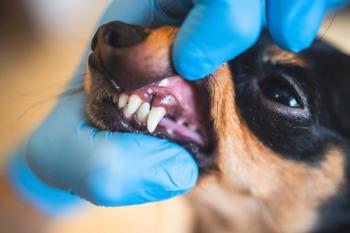
Managing jaw fractures (Proceedings)
The diagnosis and treatment of oral trauma includes the management of jaw fractures and the management of temporomandibular luxations.
The diagnosis and treatment of oral trauma includes the management of jaw fractures and the management of temporomandibular luxations.
Prior to correction of jaw fractures the patient must be thoroughly evaluated for other traumatic injuries. Following stabilization of life-threatening injuries jaw fractures can be evaluated under sedation or general anesthesia. The mandible, maxillofacial bones, and temporomandibular joints are palpated both extra- and intraorally for fractures. Radiographs are taken to localize the fracture sites. It is important to assess the full extent of all injuries keeping in mind that multiple fractures may be present. In cases of severe maxillofacial trauma, computed tomography may be helpful in the recognition of all lesions.
The teeth need to be evaluated for periodontal and endodontic disease and their relationship to fracture lines must be determined. Previous reports indicate that pathologic fractures may occur in the mandible of dogs with severe periodontal disease through deep periodontal pockets. These pathologic fractures occur most frequently in the region of the mandibular first molars and canine teeth. Periodontally diseased teeth in a fracture line need to be extracted or hemisected to remove the periodontally affected tooth or root that predisposed the dog to the pathologic fracture. Retention of a periodontally diseased tooth or root in a fracture site inhibits fracture healing. If hemisection is chosen as the method of treatment, the retained root must be treated endodontically. In addition teeth that are fractured with pulpal exposure require endodontic therapy.
Teeth that are not diseased but are located in the fracture site can generally be retained. Prognostic factors of teeth in the fracture site have been reported with fractures extending along the periodontal ligament to the apex having the poorest prognosis. In general it is probably best to retain teeth that significantly contribute to fracture stability as long as severe periodontal disease is not present and the fracture is acute.
Basic principles of jaw fracture management include the following: (1) restoration of occlusion and anatomic reduction of the fracture, (2) neutralization of forces on the fracture line and stable fixation, (3) avoidance of soft tissue entrapment by the fixation technique, (4) avoidance of further dental trauma, (5) proper assessment of tissue viability, (6) removal of diseased teeth with the fracture site, (7) avoidance of excessive elevation of soft tissue from the surface of the bone and covering of exposed bone with soft tissue, and (8) rapid restoration of function.
Several techniques for the management of mandibular and maxillary fractures have been described and include: (1) tape muzzles, (2) circumferential wiring, (3) interdental splints, (4) percutaneous skeletal fixation, (5) bone plating, and (6) partial mandibulectomy.
Tape muzzles are an inexpensive, noninvasive technique of aligning and stabilizing jaw fractures. They can be used to temporarily stabilize jaw fractures prior to definitive repair. Tape muzzles can also be utilized as the primary repair technique in minimally displaced stable fractures especially fractures of the mandibular ramus or fractures occurring in young animals in which bone healing occurs rapidly.
Interdental splints are an easy, noninvasive, versatile, and inexpensive technique for repairing jaw fractures. Prior to application of an interdental splint the teeth should be cleaned, polished, acid-etched, rinsed and dried. A self-mixing Bis Acryl-composite material can then be applied to the lingual surface of mandibular teeth or the labial aspect of maxillary teeth in the fabrication of interdental acrylic splints. Interdental splints are removed by sectioning the splint interdentally with a bur and gently removing the splint in segments using extraction forceps in a shearing motion to avoid fracturing teeth. Following splint removal the teeth are polished.
Percutaneous skeletal fixation devices may be used to repair jaw fractures. This technique is particularly useful in fractures in which there is significant soft tissue trauma, in severely comminuted fractures and in fractures in which a significant boney defect is present.
Bone plates provide rigid fixation and rapid return to function. However, bone plates can be technically challenging to place without damaging teeth. Significant soft tissue elevation is necessary for the placement of bone plates which may further compromise the blood supply of the fractured bone. It is also difficult to apply a bone plate to a fractured mandible or maxilla without further traumatizing tooth roots or neurovascular structures. It is also difficult to achieve normal postoperative occlusion using plates for jaw fracture repair because even slight errors in reduction of a fracture particularly in caudal fractures will result in a significant malocclusion with inability of the patient to close the mouth in some cases. Miniplates may be utilized in the repair of mandibular and maxillary fractures. The small size of these implants allows placement close to the alveolar border and the screws may be angled to avoid impringement on tooth roots.
Treatment of temporomandibular luxations includes reduction of the luxation and stabilization of the joint. Either a tape muzzle or intercanine splinting technique (splinting of the maxillary and mandibular canine teeth together bilaterally) can be utilized in the stabilization of the temporomandibular joints until the joint has regained stability.
Partial mandibulectomy can be utilized in the management of mandibular fractures when extensive trauma or infection precludes reduction or adequate fixation. Partial mandibulectomy techniques should be limited to cases in which primary fracture repair is likely to fail or cases in which primary fracture repair has resulted in an inability to eat and drink.
Maxillofacial fracture complications can be subdivided into the following categories. Complications in juvenile patients include interference with future growth potential resulting in facial deformities and damage to unerupted permanent teeth. Young patients with maxillofacial trauma should be treated conservatively. Factors that may complicate the treatment of maxillofacial fractures in geriatric patients include concurrent systemic diseases and severe periodontal disease with associated bone loss and an increased risk of pathologic fractures and neoplasia. Geriatric patients also have a higher incidence of postoperative complications such as delayed and nonunions.
Several maxillofacial fracture complications may be related to implants. These potential complications include implant exposure, loosening of implants and migration and implant failure. Several factors can influence the normal healing process following maxillofacial trauma. These factors include the age of the patient, the amount of stability following fixation of the fracture site, bone loss at the fracture site, location of the fracture, integrity of the regional soft tissues, the blood supply at the fracture site, and foreign material in the fracture site. These factors have a significant impact on the potential development of healing complications including an increased incidence in the development of delayed union, non-union, and malunion. The major contributing factor to the development of delayed and nonunion is inadequate fracture stability. Additional factors that may contribute to the these complications include: vascular impairment, large fracture gaps, interposed soft tissues, infection, and inappropriate use of skeletal implants. Teeth in the line of the fracture may also delay or prevent healing particularly if the teeth in the fracture site are diseased or loose. Infectious complications that may be associated with maxillofacial trauma include: wound infections, osteomyelitis and bony sequestra. These complications are treated with thorough wound debridement and administration of broad spectrum antibiotics based on culture and sensitivity testing. Malocclusion and various dental pathological conditions may be complicating factors in the management of maxillofacial fractures. Failure to align fracture segments properly during fixation may result in significant malocclusions postoperatively. This may require removal of fixation devices, proper realignment and restabilization. When postoperative traumatic occlusion is limited to one or two pairs of teeth, selective extraction may be elected as an alternative treatment plan.
Dental pathology that may be related to maxillofacial fracture complications include: periodontal, endodontic and iatrogenic conditions. Geriatric small breed dogs with severe periodontal disease may be predisposed to pathologic fractures through circumferential periodontal defects in the region of the mandibular first molars and deep periodontal pockets around the canine teeth. Management of these difficult cases includes extraction of periodontally diseased teeth placement of a cancellous bone graft combined with some type of fixation. Teeth in a fracture line can have a significant effect on fracture healing. The decision to extract or retain a tooth in a fracture line is based on several factors including: timing of fracture repair, the presence of concurrent dental disease, and location of the fracture line in relation to the root. In general, retention of healthy teeth can improve the operator's ability to achieve anatomic reduction and stabilization of the fracture site. Severely compromised teeth require extraction. Occasionally complications may occur following maxillofacial trauma because of extensive callus formation. Extensive callus formation in the region of the temporomandibular joint or between the zygomatic arch and the coronoid process of the mandible may result in limited or inability to open the mouth. Extensive callus formation may necessitate the performance of one or more surgical procedures including: condylectomy, surgical removal of the zygomatic arch and/or coronoidectomy.
Frequent physical and radiographic evaluations of patients following maxillofacial trauma can help minimize serious postoperative complications and permit early detection of problems. Diligent postoperative care will help minimize postoperative pain and shorten the postoperative recovery period.
References
Holmstrom SE, Frost P, Eisner ER: Endodontics. In: Holmstrom SE, Frost P, Eisner ER, eds. Veterinary Dental Techniques. Philadelphia: WB Saunders, 1998:255-318.
Manfra Marretta S. Maxillofacial surgery. Vet Clin North Amer (Small Anim Pract) 1998;28(5):1285-1296.
Gorrel C: Emergencies. In: Gorrel C, ed. Veterinary Dentistry for the General Practitioner. WB Saunders, 2004:131-155.
Newsletter
From exam room tips to practice management insights, get trusted veterinary news delivered straight to your inbox—subscribe to dvm360.






